December 25, 2006
Merry Christmas ! Click Here for our Christmas Card
posted by Peggy at 5:57 PM
December 24, 2006
A Visit from Saint Nicholas (In the Ernest Hemingway Manner)
by James Thurber
from The New Yorker magazine issue 1927-12-24
This classic New Yorker holiday story, from 1927, appears in the anthology “Christmas at The New Yorker,” which was published by Random House.
It was the night before Christmas. The house was very quiet. No creatures were stirring in the house. There weren’t even any mice stirring. The stockings had been hung carefully by the chimney. The children hoped that Saint Nicholas would come and fill them.
The children were in their beds. Their beds were in the room next to ours. Mamma and I were in our beds. Mamma wore a kerchief. I had my cap on. I could hear the children moving. We didn’t move. We wanted the children to think we were asleep.
“Father,” the children said.
There was no answer. He’s there, all right, they thought.
“Father,” they said, and banged on their beds.
“What do you want?” I asked.
“We have visions of sugarplums,” the children said.
“Go to sleep,” said mamma.
“We can’t sleep,” said the children. They stopped talking, but I could hear them moving. They made sounds.
“Can you sleep?” asked the children.
“No,” I said.
“You ought to sleep.”
“I know. I ought to sleep.”
“Can we have some sugarplums?”
“You can’t have any sugarplums,” said mamma.
“We just asked you.”
There was a long silence. I could hear the children moving again.
“Is Saint Nicholas asleep?” asked the children.
“No,” mamma said. “Be quiet.”
“What the hell would he be asleep tonight for?” I asked.
“He might be,” the children said.
“He isn’t,” I said.
“Let’s try to sleep,” said mamma.
The house became quiet once more. I could hear the rustling noises the children made when they moved in their beds.
Out on the lawn a clatter arose. I got out of bed and went to the window. I opened the shutters; then I threw up the sash. The moon shone on the snow. The moon gave the lustre of mid-day to objects in the snow. There was a miniature sleigh in the snow, and eight tiny reindeer. A little man was driving them. He was lively and quick. He whistled and shouted at the reindeer and called them by their names. Their names were Dasher, Dancer, Prancer, Vixen, Comet, Cupid, Donder, and Blitzen.
He told them to dash away to the top of the porch, and then he told them to dash away to the top of the wall. They did. The sleigh was full of toys.
“Who is it?” mamma asked.
“Some guy,” I said. “A little guy.”
I pulled my head in out of the window and listened. I heard the reindeer on the roof. I could hear their hoofs pawing and prancing on the roof. “Shut the window,” said mamma. I stood still and listened.
“What do you hear?”
“Reindeer,” I said. I shut the window and walked about. It was cold. Mamma sat up in the bed and looked at me.
“How would they get on the roof?” mamma asked.
“They fly.”
“Get into bed. You’ll catch cold.”
Mamma lay down in bed. I didn’t get into bed. I kept walking around.
“What do you mean, they fly?” asked mamma.
“Just fly is all.”
Mamma turned away toward the wall. She didn’t say anything.
I went out into the room where the chimney was. The little man came down the chimney and stepped into the room. He was dressed all in fur. His clothes were covered with ashes and soot from the chimney. On his back was a pack like a peddler’s pack. There were toys in it. His cheeks and nose were red and he had dimples. His eyes twinkled. His mouth was little, like a bow, and his beard was very white. Between his teeth was a stumpy pipe. The smoke from the pipe encircled his head in a wreath. He laughed and his belly shook. It shook like a bowl of red jelly. I laughed. He winked his eye, then he gave a twist to his head. He didn’t say anything.
He turned to the chimney and filled the stockings and turned away from the chimney. Laying his finger aside his nose, he gave a nod. Then he went up the chimney. I went to the chimney and looked up. I saw him get into his sleigh. He whistled at his team and the team flew away. The team flew as lightly as thistledown. The driver called out, “Merry Christmas and good night.” I went back to bed.
“What was it?” asked mamma. “Saint Nicholas?” She smiled.
“Yeah,” I said.
She sighed and turned in the bed.
“I saw him,” I said.
“Sure.”
“I did see him.”
“Sure you saw him.” She turned farther toward the wall.
“Father,” said the children.
“There you go,” mamma said. “You and your flying reindeer.”
“Go to sleep,” I said.
“Can we see Saint Nicholas when he comes?” the children asked.
“You got to be asleep,” I said. “You got to be asleep when he comes. You can’t see him unless you’re unconscious.”
“Father knows,” mamma said.
I pulled the covers over my mouth. It was warm under the covers. As I went to sleep I wondered if mamma was right.
posted by Peggy or Guy at 6:55 PM
December 23, 2006 
Space Shuttle Discovery touched down on Kennedy Space Center's Runway 15 at 5:32 p.m. EST on Dec. 22, wrapping up a resoundingly successful mission to rewire the International Space Station and retract a stubborn solar array.
"It's a little bit windy and a little bit rainy. And we just want to go ahead and thank everybody for helping get us back to Kennedy Space Center. Discovery is a beautiful vehicle," said Commander Mark Polansky before the crew departed the Shuttle Landing Facility. "This mission is really a demonstration of how well we can work as a team at NASA when the ground folks, and the contractors, the crew, the flight directors, the control teams when everybody works together toward a common goal."
NASA officials also expressed their satisfaction with the mission's outcome during a post-landing news conference.
"On behalf of the crew at the Kennedy Space Center, Christmas came three days early for us," agreed Launch Director Mike Leinbach. "It is great to have Discovery out on our runway. The team is just jubiliant."
Before setting foot on the runway, each crew member underwent a brief medical exam inside the Crew Hatch Access Vehicle. After receiving an OK by doctors, Commander Mark Polansky and his team were greeted by NASA officials, including Administrator Michael Griffin, before taking a walk around Discovery to inspect the spacecraft.
Discovery launched on Dec. 9 and arrived at the station on the 11th. The crew installed the P5 spacer truss segment during the first of four spacewalks. Spacewalkers rewired the station’s power system during the second and third spacewalks, leaving it in a permanent setup. A fourth spacewalk was added to allow the crew to retract solar arrays that had folded improperly.
Discovery also delivered a new crew member and more than two tons of equipment and supplies to the station, most of which were located in the SPACEHAB cargo module. Almost two tons of items no longer needed on the station returned to Earth with Discovery.
The crew spent almost 13 days in space and traveled 5.3 milion statute miles. The mission was the 117th space shuttle flight and 33rd by Discovery. STS-116 also was the 20th shuttle mission to visit the space station.
posted by Peggy or Guy at 8:09 PM
December 22, 2006
Who is this then?

posted by Peggy or Guy at 9:15 PM
December 21, 2006 The Outhouse
The term outhouse originally referred to an outbuilding, or any small structure away from a main building, used for a variety of purposes, but mainly for activities not wanted in the main house. Outhouses are used for storage, animals, and cooking, to name a few uses. Larger structures have names such as barn or stable.
In North American English, an outhouse (sometimes also called a backhouse) is now a small enclosure around a pit that is used as a toilet.
Outhouses vary in design and construction. Common features usually include:
* A separate structure from the main dwelling, close enough to allow easy access, but far enough to minimize smell.
* Walls and a roof to shield the user from rain, wind, and thus to a small degree, cold weather.
* Having a door, sometimes decorated with a small crescent moon-shaped hole. The significance of the moon has never been fully explained. In Germany, a heart-shaped hole is traditional. In recent centuries, the finer inns began offering "his" and "hers" outhouses. But, because most people were illiterate, symbols were used on the outhouses to show which was "his" and which was "hers". Pictures of the sun and moon were the obvious choice. From ancient times, the "sun" had been a symbol of all that was masculine and the "moon" of all that was feminine.
* In Western societies, there is at least one seat with a hole in it, above a small pit.
* In Eastern societies, there is a hole in the floor, over which the user crouches.
* There are a suitable distance away from any freshwater well, so as to minimize risk of contamination.
* Sometimes having a roll of toilet paper available. Catalogs from retailers specializing in mail order purchases, such as the Montgomery Ward catalog, were also common before toilet paper was widely available, often kept in a can or other container to protect it from mice, etc. Old corn cobs, leaves, or other paper was also used.
Outhouses are common throughout history. Outhouse humor is likewise a constant, which usually involves someone either being trapped in one, falling into the hole, or other social faux pas. Aside from generic bathroom jokes, some are specific to outhouses, such as this time-honored one-liner, which any rural sort might say, usually making fun of his background:
"We had a fire in the bathroom; luckily, it didn't spread to the house!"
Maine humorist Marshal Dodge told the story of a carpenter building an outhouse for a customer who constantly made changes to the location, which way the door was to face, the pitch of the roof, etc. Finally he complains that he specified a two-holer, and the carpenter is only cutting one. The carpenter replies: "By the time you'd decide which hole to use.....it'd be too late."
posted by Peggy or Guy at 9:27 PM
December 20, 2006
Who do you think this could be?
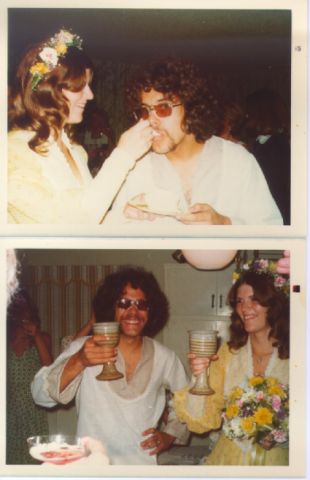
posted by Peggy or Guy at 11:00 PM
December 19, 2006
Is It the Sound of One Hand Clapping?
What does this song mean? Upon doing some research it is said that this song was written from the memory of climbing a mountain. From afar there is a mountain, but when ascending there is no mountain, only the trail. Once ascended the view informs you that you are atop the mountain.
The lock upon my garden gate's a snail, that's what it is.
The lock upon my garden gate's a snail, that's what it is.
First there is a mountain, then there is no mountain, then there is.
First there is a mountain, then there is no mountain, then there is.
The caterpillar sheds his skin to find a butterfly within.
Caterpillar sheds his skin to find a butterfly within.
First there is a mountain, then there is no mountain, then there is.
First there is a mountain, then there is no mountain, then there is.
Donovan P. Leitch
posted by Peggy or Guy at 10:49 PM
December 18, 2006
Do you know who this is?
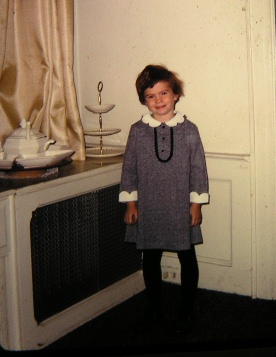
posted by Peggy at 10:25 PM
December 17, 2006
Lost Dockets from Los Angeles Magazine
Sally R. Plaintiff
vs
Stan W. Defendant
Allegations: Plaintiff accuses defendant of infinite ignorance when he mentioned to her that
"EMPLOYEE OF THE MONTH"
was "really, really good." After spending 103 minutes in misery. Plaintiff seeks the return of her $10.50 for pain and suffering, plus reimbursement of parking and additional $16.25 for large popcorn and Raisinets at next movie.
posted by Peggy or Guy at 12:00 AM
December 16, 2006 Do you know who this is?
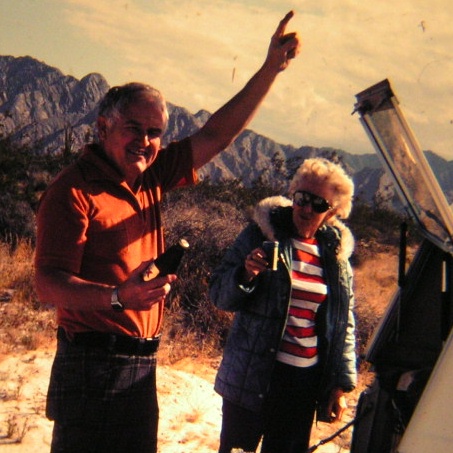
posted by Peggy or Guy at 12:01 AM
December 15, 2006
Early US History of Aircraft Carriers
Nov. 14, 1910 - Eugene Ely, 24, a civilian pilot, took off in a 50-hp. Curtiss plane from a wooden platform built over the bow of the light cruiser USS Birmingham (CL-2). The ship was at anchor in Hampton Roads, Va., and Ely landed moments later on Willoughby Spit.
Jan. 18, 1911 - At 11:01 a.m., Eugene Ely, flying a Curtiss pusher, landed on a specially built platform aboard the armored cruiser USS Pennsylvania (ACR 4) at anchor in San Francisco Bay. At 11:58 a.m., he took off and returned to Selfridge Field, San Francisco.
Nov. 5, 1915 - Lieut. Cmdr. Henry C. Mustin made the first catapult launching from a ship. He flew an AB-2 flying boat off the stern of USS North Carolina (ACR 12) in Pensacola Bay, Fla.
Jul. 11, 1919 - The Naval Appropriations Act for Fiscal Year 1920 provided for the conversion of the collier Jupiter into a ship specifically designed to launch and recover airplanes at sea — an aircraft carrier — later to be named Langley. The engineering plans for this conversion were modified in November and included catapults to be fitted on both the forward and after ends of the "flying-off" deck.
Mar. 20, 1922 - USS Langley (CV 1), converted from the collier USS Jupiter (AC 3), was placed in commission at Norfolk, Va., as the Navy's first aircraft carrier. The ship's executive officer, Cmdr. Kenneth Whiting, was in command.
Apr. 1, 1922 - The specifications of arresting gear of the type later installed in early aircraft carriers were sent to various design engineers. "The arresting gear will consist of two or more transverse wires stretched across the fore and aft wires ... [and which] lead around sheaves placed outboard to hydraulic brakes. The plane, after engaging the transverse wire, is guided down the deck by the fore and aft wires and is brought to rest by the action of the transverse wire working with the hydraulic brake."
Oct. 17, 1922 - Lieut. V.C. Griffin, in a Vought VE-7SF took off from USS Langley at anchor in the York River, Virginia, making the first take-off from an aircraft carrier.
Oct. 26, 1922 - Lieut. Cmdr. Godfrey deC. Chevalier, flying an Aeromarine, made the first landing aboard USS Langley underway off Cape Henry, Virginia.
Nov. 18, 1922 - Cmdr. Kenneth Whiting, piloting a PT seaplane, made the first catapult launching from USS Langley (CV 1) at anchor in the York River.
Nov. 17, 1924 - Langley reported for duty with the Battle Fleet, thereby ending two years in an experimental status and becoming the first operational aircraft carrier in the U.S. Navy. On 1 Dec., she also became the flagship for Aircraft Squadrons, Battle Fleet.
Jan. 11, 1928 - The first take off and landing aboard USS Saratoga (CV 3) was made by the ship's Air Officer Cmdr. Marc A. Mitscher in a UO-1.
Sept. 26, 1931 - The keel for USS Ranger (CV 4), the first ship of the U.S. Navy to be designed and constructed as an aircraft carrier, was laid at the Newport News Shipbuilding and Drydock Company in Newport News, Va. The ship was launched on 25 Feb. 1933, and commissioned 4 Jun. 1934 at the Norfolk Navy Yard, Capt. Arthur L. Bristol, commanding.
Nov. 1, 1934 - The Naval Aircraft Factory was authorized to manufacture and test a flush-deck hydraulic catapult, Type H Mark I. This catapult was designed to launch land planes from aircraft carriers and was the Navy's initial development of a hydraulic catapult, a type which was to be the primary means of launching land planes from carriers.
Jun. 11-13, 1939 - USS Saratoga (CV 3) and the tanker USS Kanawha (AO 1) conducted underway refueling tests off the coast of southern California, demonstrating the feasibility of refueling carriers at sea.
posted by Peggy or Guy at 9:24 PM
December 14, 2006
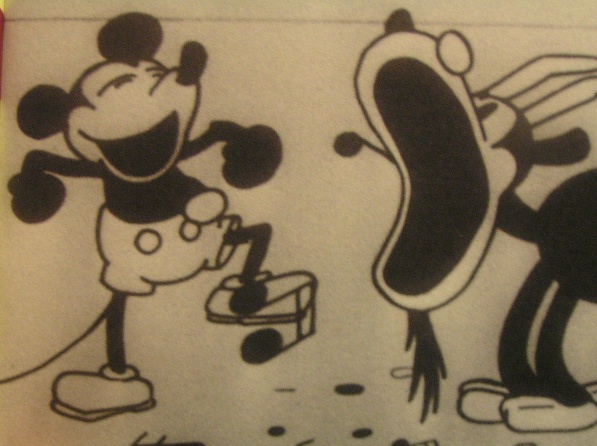
Animator Ub Iwerks completed Steamboat Willie as a silent film. Sound was post-synchronized to match the action. The very first attempt to sync sound with Steamboat Willie’s action was a crude one: artist Wilfred Jackson, Iwerks and Disney played along with a harmonica, washboard, cowbell, frying pan, plumbing tools, and ocarinas.
Walt sold his beloved Moon Cabriolet roadster to finance the recording sessions with the New York’s Broadway Strand Theater orchestra.
At first conductor Carl Edouarde found it impossible to coordinate his orchestra with the character’s movements in Steamboat Willie. Iwerks solved the problem by making a special print of the film with an animated bouncing ball. The ball bounced along in the rhythms the composer had devised to highlight and punctuate the action. Instead of being projected above the orchestra, Iwerks’s special print was projected directly down onto Edouarde’s printed score. In this way, Iwerks created a film that could conduct the conductor.
posted by Peggy at 11:08 PM
December 13, 2006First PresidentialJames Madison was the first president to wear trousers rather than knee breeches. James Monroe was the first president to ride a steamboat. John Quincy Adams was the first president to be photographed. Andrew Jackson was the first president to ride in a train. Martin Van Buren was the first president born in the United States. The presidents preceding Van Buren were born in colonies that later became states. James Polk was the first president to have his inauguration reported by telegraph. Franklin Pierce was the first president to have a Christmas tree in the White House. Abraham Lincoln was the first president to wear a beard and the tallest president at 6’ 4". Ulysses S. Grant established Yellowstone as the nation's first national park on March 1, 1872. Grover Cleveland was the first president to personally answer the White House phone. Benjamin Harrison was the first president to use electricity in the White House. After he got an electrical shock, his family often refused to touch the light switches and sometimes would go to bed with the lights on. Grover Cleveland was the first president to have a child born in the White House; his daughter Esther in 1895. William McKinley was the first president to ride in an automobile. William Taft was the first president to own a car. Woodrow Wilson was the first president to have earned a Ph.D. Warren Harding was the first president to speak over the radio. Herbert Hoover was the first president born west of the Mississippi River. Franklin Roosevelt was the first president whose mother was eligible to vote for him. Harry S. Truman was the first president to travel underwater in a submarine and the first to give a speech on television. John F. Kennedy was the first president born in the 20th century. Lyndon Johnson was the first president to name an African American to his cabinet. Richard Nixon was the first president to visit all 50 states. Jimmy Carter was the first president born in a hospital.
posted by Peggy or Guy at 10:50 PM
December 12, 2006
I HEAR LOVEI hear love in children’s laughter. I feel love in nature’s breeze. I feel love when I am praying Or I sing love’s melody. Love can lift me up to heaven When my heart feels like a stone. Love can make me feel connected When it looks like I’m alone. *************************** CHORUS; Ain’t a’gonna hold my love too tightly, I’m a’gonna pass my love along. You can see it when I’m grinnin’ You can hear it in my song. You can add your voice with gusto, We can sing a love duet. And together we can show the world How good shared love can get. ***************************** Love is best when it’s spontaneous When all the world is right. When our path is smooth and easy And the sun is shining bright. But reserve a place within yourself Where love can hold full sway. Then when problems complicate your life Just love them all away. CHORUS Love will lighten even gravity When life’s a heavy load. Changing stumb’ling blocks to stepping stones Along a bumpy road. Love can raise our sights to treasures That our eyes have missed before And when you let your love flow out You’ve just made room for more! CHORUS Can be sung with the tune from “This Old House” by Stuart Hamblen These words written by Bob Scott
posted by Peggy at 10:11 PM
December 11, 2006Peggy has changed her puzzles on the Puzzle Page. Click on the picture to try them.

posted by Peggy at 11:03 PM
December 10, 2006
Discovery Liftsoff
Space Shuttle Discovery and a crew of seven astronauts lifted off Saturday from Kennedy Space Center at 8:47 p.m. EST. After reaching orbit, Discovery’s crew set to work to open the payload bay doors, set up computers and equipment and check out the shuttle’s robotic arm. Heat shield inspections will begin Sunday with a station docking scheduled for Monday at 5:05 p.m.
The STS-116 crew members will dock to the International Space Station, install the new P5 truss structure and perform three spacewalks to rewire the station for electricity generated by a solar array delivered in September.
STS-116 will also swap crew members when mission specialist Sunita Williams becomes a flight engineer for Expedition 14. Taking Williams' place aboard Discovery for the ride home is European Space Agency astronaut Thomas Reiter who has lived aboard the station since July.
NASA wants Discovery back from its 12-day mission by New Year's Eve because shuttle computers are not designed to make the change from the 365th day of the old year to the first day of the New Year while in flight. The agency has developed a fix, but would prefer not to try it.
When the shuttle lifted off it weighed 4,521,350 pounds.
from the NASA website.
posted by Peggy or Guy at 9:48 PM
December 9, 2006 Transhumance and Barb Wire
The transition of open prairie to enclosures of barbed wire was actually a social revolution among the early-day settlers and ranchers. To some, it was a threat to job security, to others it was the only solution to continued living on the Great Plains. To most, it meant a complete change of traditions, daily work and the acceptance of a new way of life.
From the 1500s to 1800, livestock enclosures consisted of rail fences where timber existed, rock walls where stone was available, brush, cactus or hedge fences and ditches. The shortage of raw materials and the amount of labor required in construction limited these fences to small enclosures around homesteads and ranches.
To raise and harvest crops required the complete control of livestock and large poultry. The old Spanish method of “transhumance,” handed down from the old world countries, prevailed allowing farms to produce food crops. Since most of the early-day farming was limited to small plots along river bottoms and creek areas, the outlying hills and plains were ideal on which to graze the various community herds and flocks.
Transhumance is defined as, “the periodic removal of all livestock except draft and milk animals from farming areas during the planting, growing and harvesting of food crops." Basically, this meant the period of time from April 1 to October 1 each year.
To accomplish this an entire annual schedule for the community had to be planned at the first of each year, dates for roundups and livestock removal set and rules made to enforce these events.
In early Mexico, the ruling counsel responsible for transhumance duties was the Mexican Mesta, hearing all complaints, making all decisions and deciding all laws. Also the Mesta attended all tax assessments, brand regulations, stray stock treatment, roundup and trail drive rules and set damages caused by livestock
Carrying out transhumance duties required that all cattle, horses, mules and burros were properly branded before removal then carried to the hills and grasslands for summer graze. All sheep and goats were identified and driven to brushy areas for summer graze. All swine and turkeys were identified as to ownership and driven to low lying bog areas for the summer season
The older men and young boys, incapable of strenuous labor tended the herds and guarded them from bandits and predators. After the fall crops were harvested in the communities, the livestock were returned to graze the crop residue. At this time the surplus animals were sold for income or butchered as needed for food.
To prevent damages to crops, continual around-the-clock vigilance was almost a necessity to ensure a crop could be harvested. A rigid schedule kept by all family members was necessary to comply with transhumance rules in order to prevent damage to growing crops. To those who existed for centuries under these conditions, the advent of barbed wire fencing seemed like a miracle.
by Delbert Trew -1998
posted by Peggy or Guy at 11:30 PM
December 8, 2006Did you know, officials at the New York World's Fair in 1939 locked away an Ingersoll Mickey Mouse wrist watch in the fair's time capsule. The reopening ceremony: 5939
posted by Peggy at 9:48 PM
December 7, 2006
This famous celebrity goes by many names around the world.
Do you know who this could be?
In which language is the name the same as in English?
Mickie................Afrikaans
Mickey................Arabic
Mai Kay Shiu Shu......Cantonese
Mikki Hiiri...........Finnish
Mickey Maus...........German
Mikki Maous...........Greek
Miki Eger.............Hungarian
Topolino..............Italian
Michael Musculus......Latin
Mi Lao Shu............Mandarin
Mikke Mus.............Norwegian
Mickey................Portuguese
Mikki Maus............Russian
El Raton Mickey.......Spanish
Musse Pigg............Swedish
Miki..................Turkish
Mic-Kay...............Vietnamese
posted by Peggy at 12:36 AM
December 6, 2006
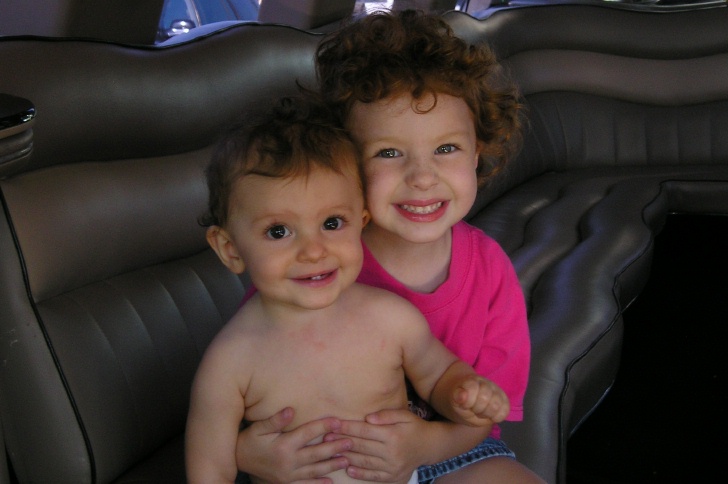
Do you know who this is?
posted by Peggy at 10:55 PM
December 5, 2006Before the development of modern refrigeration, ice cream was a luxury item reserved for special occasions. Making ice cream was quite laborious. Ice was cut commercially from lakes and ponds during the winter and stored in large heaps in holes in the ground or in wood-frame ice houses, insulated by straw. Ice cream was made by hand in a large bowl surrounded by packed ice and salt. The temperature of the ingredients was reduced by the mixture of crushed ice and salt. The salty water was cooled by the ice, and was liquid below the freezing point of pure water. The immersed container can make better contact with the salty water and ice mixture than it could with ice alone. The hand-cranked churn, which still used ice and salt for cooling, was invented by an American named Nancy Johnson in 1846, making production possible on site and avoiding the problem of continuous chiling between production and consumer. Ice cream became a popular item for the first time. The world's first commercial ice cream factory was opened in Baltimore, Maryland in 1851, by Jacob Fussell, a dairy farmer. An unstable demand for his milk led him to mass produce ice cream. This allowed the previously expensive concoction to be offered in the city at reduced prices. Fussell opened ice cream parlors as far west as Texas. Many were still around well into the 20th century. Fussell later sold his business to Borden. The development of industrial refrigeration by German engineer Carl von Linde during the 1870s eliminated the need to cut and store natural ice and when the continuous-process freezer was perfected in 1926, allowed commercial mass production of ice cream and the birth of the modern ice cream industry. From wikipedia.com
posted by Peggy or Guy at 11:31 PM
December 4, 2006
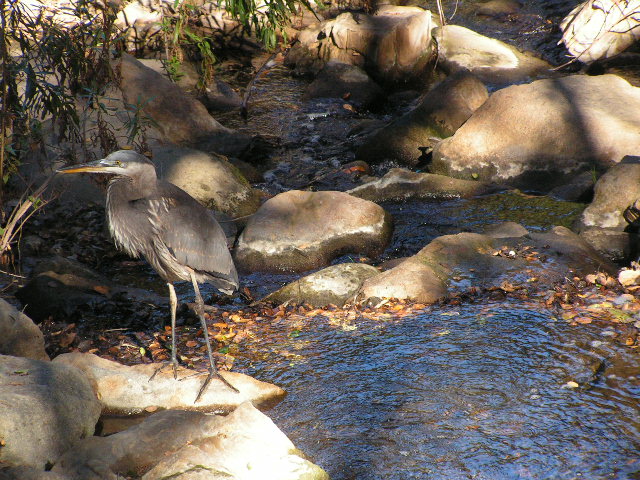
This is a great blue heron seen and photographed by Peggy at the Anaheim Hills Nature Center.
posted by Peggy at 10:25 PM
December 3, 2006Every human being is a raindrop. And when enough of the raindrops become clear and coherent they then become the power of the storm. What it Means to Be a Human Being speech, San Francisco, CA, March 2001 John Trudell
posted by Peggy or Guy at 9:41 PM
December 2, 2006
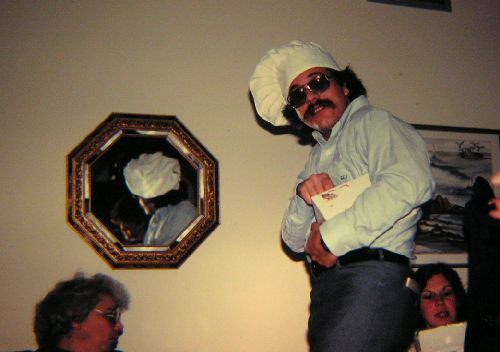
Who is that? Does anyone know?
posted by Peggy or Guy at 11:33 PM
December 1, 2006
Be heedful of the simple things that brighten up the day
That help you through the troubled times that you face along the way.
For life has small reminders that will lead us from our pain
A ray of sun,
A sudden breeze,
The gentle touch of rain.
a poem written by Peggy
posted by Peggy or Guy at 9:08 AM
November 30, 2006You may have guessed this already, but there is no Audio Advent Calendar this year. If you still have some older copies, I guess you could listen to one of them.
posted by Peggy or Guy at 8:32 PM
|









